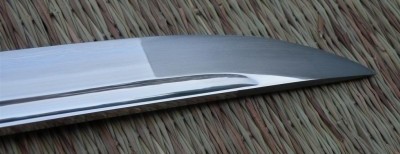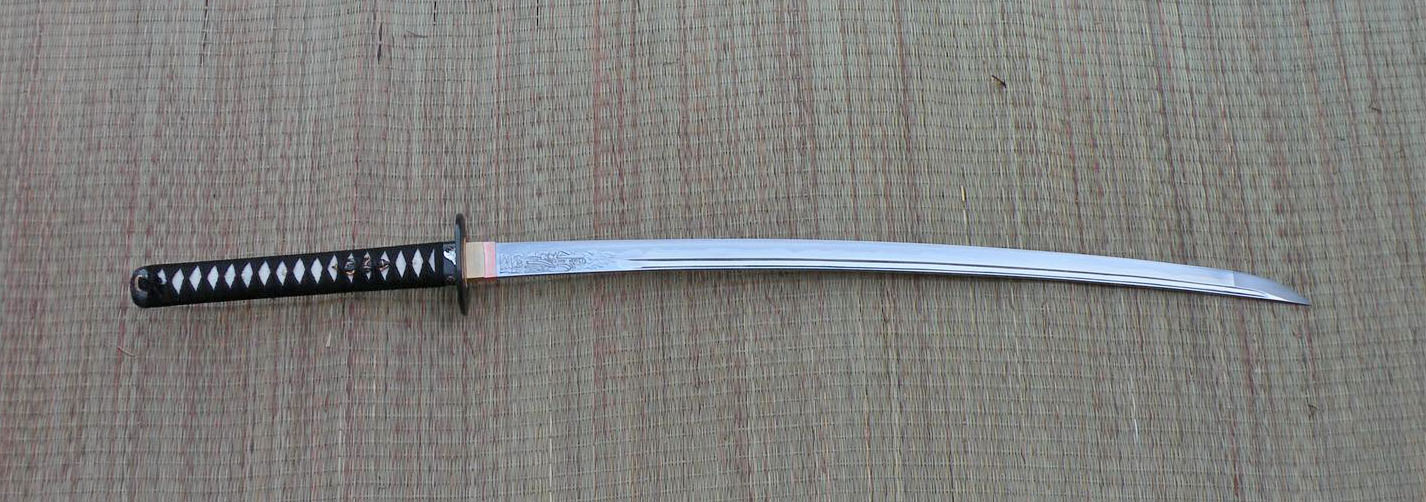
Which Steel Types for Japanese Swords?
The origins of forging and the extent to which katanas were forged in the past is important to explore in more detail.
Katanas are made of steel. Steel is an alloy between iron and carbon and the carbon gives the hardness to the blade. Iron without Carbon would be very soft, but Carbon alone would lead to a brittle blade. The most optimal mechanical properties for a leaf therefore require both properties. It is good to know that the quality of the blade of Japanese katanas was not that good at the time and that is why the steel was folded to achieve a more homogeneous mass. This is the traditional way of forging from Japan. Folding also ensures that impurities disappear and the carbon content can spread.
Current types of steel are usually made in blast furnaces and therefore have a much more homogeneous and cleaner mass. The material was completely different, Tamahagane, also called Jewel steel, was used . This was and is made of iron sand and carbon in a Tatara . This is a very long and complex process that requires four or five people to work continuously for a week. During this week, during which the necessary preparations are first made, the oven is ultimately left on for 72 hours, with iron sand and coal being added each time. Ultimately, Kera remains , which is ultimately used to forge the blade.
Kera consists of chunks with low carbon and high carbon content. The steel with a low carbon content ( hocho-tetsu ) is used for the inside of the blade, the outside is formed by steel with a high carbon content ( nabe-gane ). This process is strictly regulated by the NBTHK ( Nihon Bijutsu Token Hozon Kyokai ), which was founded in 1948 and was recognized by the Japanese government as an official body that had to ensure the (further) existence of Japanese sword culture and especially its traditional production. Making a katana is therefore a very complex process.
What is offered today are usually the steel types below.
Carbon Steel 10xx (including 1045, 1060, 1075 & 1095)
- T10 steel
- 9260 steel
- Swedish Powder Steel (ASSAB K120C)
- L6 shank
- Tamahagane Steel
These types of steel, with the exception of Tamahagane steel, therefore have a much more homogeneous mass than the iron sand originally used by the samurai. Ultimately, the question arises whether these types of steel are better, this is difficult to answer, it very much depends on which forge you are comparing.
Forges that have gained a lot of experience and know what they are doing can forge an excellently finished katana , on the other hand, there are also many, in my opinion, B-forges that mainly focus on decorative swords but want to sell it as a functional sword. Then it becomes a risky and dangerous hobby, in my opinion. By experience I mean forging and professional heat treatment. There are many Nihonto made from lower quality Tamahagane , these are surpassed in functionality by modern forged production swords.
If it is more traditional, I unfortunately have to confirm that this is not the case, but most authentic Nihonto are unaffordable for most people. There are a number of Japanese shops that offer authentic Nihonto , including my shop. The highest quality Tamahagane has a carbon content of 1-1.5%. In that respect you could say that High Carbon Steel 1095 and T10 come close. Regardless of this fact, many authentic Nihontos are found to have a carbon content of 0.7. So there is a lot of difference between the katanas .
Once again in terms of finish, most authentic Nihonto are superior to more modern swords. Unfortunately, many pieces are not well maintained or have deteriorated over time and are in much poorer condition. Nihonto are also simply too expensive and it would be a shame to do tameshigiri with them, but one can only train kata if their balance allows them to do so.
Carbon Steel 10XX
This is, I think, the most commonly used type of steel for forging a sword. The carbon content is indicated by the last two values. With HCS 1075, an average carbon content of 0.70 to 0.80. This type of steel always contains a number of other elements such as manganese, phosphorus and sulfur. The carbon therefore gives a good indication of the hardness.
T10 Steel
This is a tool steel and is also relatively common. It contains 0.95 - 1.04 Carbon and a number of other elements such as Silicon, Manganese, Phosphorus and Sulfur. This steel quality is also of high quality and with the correct processing the sword has the same properties as that made from HCS 1095. The hamon line often looks a bit vaguer and that is how you can possibly recognize it.
9260 Steel (spring steel)
9260 Spring Steel is a low alloyed high carbon steel with a very high elastic limit. This allows these swords to be very flexible and return to their original shape despite significant bending. If the steel is properly hardened through quenching , you will get a hard yet flexible sword. It is a Silicon Manganese steel with the following elements Carbon 0.56 - 0.64, Silicon, Manganese, Phosphorus and Sulfur.
Swedish Powder Steel
The forge that works with this is Hanwei . The ASSAB K120C is a powder steel, made in Japan under the supervision of SSAB from Sweden.
Powder metallurgy is the process of mixing fine powdered materials. The pressed material is bound under high pressure. This process gives the steel special properties and can be controlled with great precision. It consists of Carbon 1%, Silicon, Manganese and Sulfur. The big advantage is that the elements are controlled with great precision and the steel is incredibly pure and clean.
L6 Steel
Because the L6 / Bainite is used by Hanwei for their High End swords. Essentially, Davenport and Bain discovered this new steel microstructure in 1920. Bain's colleagues at the United States Steel Corporation named it Bainite and the scientific community adopted this name in 1947.
Hanwei adopted those theories and made this process his own. Hanwei put theory into practice and experimented with the materials until they perfected it. It is a structure of high-carbon steel that combines great strength with excellent flexibility and shock absorption properties demanding heat treatment. It contains the following elements: Carbon: 0.70 to 0.90, Chromium, Manganese, Nickel, Forfor Silicon, Vanandium and Sulfur.
Tamahagane
Some forges, including Hanwei and Huanuo, use real iron sand and the traditional furnace method to forge a tamahagane blade in a modern and efficient way .
Usually these blades are used for the folded blades and are traditionally polished with Japanese stones. About 5 to 8 stones are used for this, from coarse to increasingly fine. This treatment brings out the leaf and the hamon to their full potential.
Below is a Kami Katana from the Hanwei Forge.


